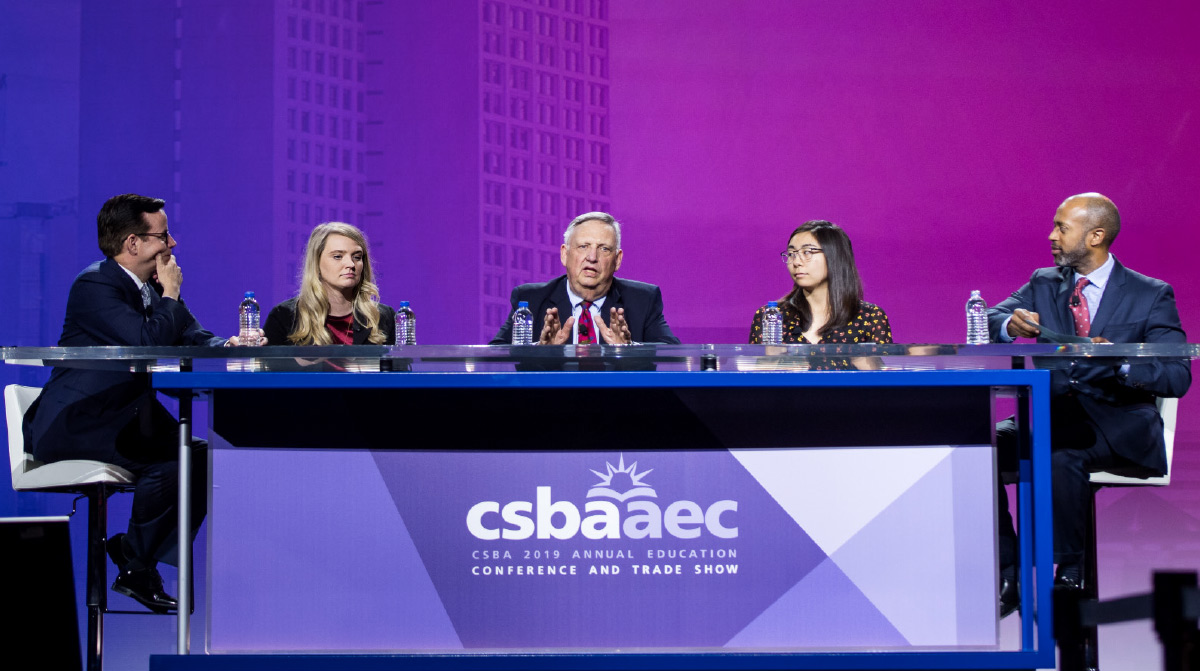The 2019 AEC closed out with an insider’s look at the politics central to California public schools. The Third General Session, moderated by CSBA CEO & Executive Director Vernon M. Billy, featured media influencers with unique perspectives on how the politics and policy of education issues unfold.
On stage with Billy were longtime Capitol affairs journalist Dan Walters of CalMatters, Politico state education reporter Mackenzie Mays, local education journalist Kristen Taketa of the San Diego Union-Tribune and Capitol Advisors Group President Kevin Gordon.
The quartet reviewed key developments in 2019 around funding, charter schools and other legislation, as well as predicted trending issues for 2020.

In addressing a heightened climate of accountability, Walters said a recent report from the California State Auditor found that Local Control Funding Formula dollars targeted for the most in-need students aren’t always reaching their intended target. “There’s going to be more of that scrutiny as to how that money is being spent and whether it’s effective,” he said.
Walters also critiqued the fixation on money as the predominant topic in California education policy while achievement and opportunity gaps persist. The point was rebutted by Billy and panelists.
“There are clearly other factors that impact student achievement, and I would also say that I agree that money is not the end-all deal, but I will also say that money is very important because money allows you to make those investments on those items, services and programs that can impact student achievement, whether it’s hiring nurses or counselors or librarians,” Billy said. “It’s reducing class sizes — that takes money. Those things can have a significant impact on the academic and social well-being of students. And I think that’s what districts are saying. ‘If you want to help us to move the needle, we have to have the money to make those types of investments.’”
“I would just love to take the risk of trying the ‘more money, maybe things work better’ approach. Because we haven’t tried it in 30 years,” Gordon added. He also said comparing other states’ funding levels and academic performance with California’s is difficult because the state’s student diversity and poverty level exceed any other state.
Politico’s Mays said her time at the Capitol has illustrated a disconnect between the reality of California’s education funding level and external perceptions. “There are people who think that the lottery is just infusing schools with tons of money, and that’s not actually true,” she said. “And Prop 98 is confusing, and a lot of people in Sacramento talk often about how it was supposed to be a floor, and is now a ceiling.”
Bringing in a local perspective, Taketa said her current reporting at San Diego-area districts and schools continues to highlight the lack of necessary resources amid rising costs and declining enrollment.
Gordon lauded CSBA and board members across the state for impressing upon Gov. Newsom insights and information regarding pension costs and long-sought charter school reforms. “He specifically mentioned ‘those school boards are just on my heels every day about a couple of key issues.’ Special ed and STRS or PERS and base funding for education. And he pushed all those buttons in his January budget,” Gordon said. “It takes us sometimes a couple of years into a new administration to get them to hear us on even big issues.”
In analyzing Gov. Newsom’s first year, Walters and Mays touched on the fact the Governor may have higher political aspirations that required compromise on several issues. For example, despite strong support from a deep blue Legislature on big charter school reforms, Mays said Gov. Newsom walked a fine line between union and charter school sector interests. “So even though it’s only been a year, there’s still been some accusations of some unfulfilled promises,” she said.
The climate of having super majorities in both houses of the Legislature with a Democratic governor can also be a cautionary one, Gordon said, as “our friends in education aren’t the people with little Ds or Rs after their name, it’s who stands up for and supports public education.”
In that vein, Billy admonished the Legislature for the continued passage of unfunded mandates, such as the late start time bill (Senate Bill 328). “That’s money that is now going away potentially from student services to something else that is a result of the legislator’s pet project,” he said. “And I think that’s frankly a violation of the State Constitution.”
There was consensus that despite early polling showing a lack of support, the $15 billion school facilities bond measure on the March 2020 ballot will more than likely pass. With a long way to go until the election, there was far less consensus about the outlook for the Schools and Communities First — or split roll — tax measure that will likely qualify for the November 2020 ballot.
There was also strong agreement that Gov. Newsom will place more of an emphasis on early education initiatives in the coming year, an area in which he has shown great interest. Included in that work could be progress on a state longitudinal data system capable of tracking youth from preschool programs all the way to college and career milestones.